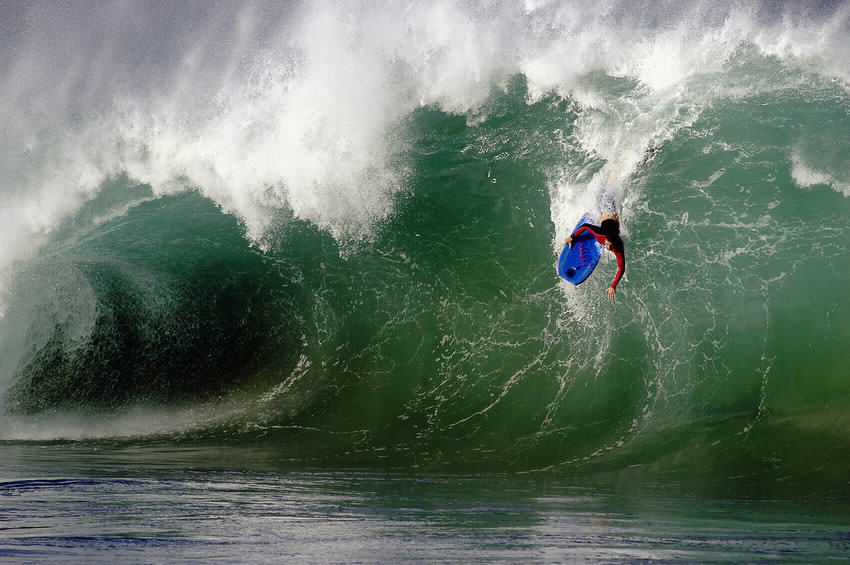If you are visiting Oahu there are lots of great sights to check out along the north shore. The best way to really experience the north shore is to get an Oahu Condo in the area and then explore the area at your leisure.
One of the first places you want to visit is Haleiwa, which is known as the “gateway” to Oahu’s north shore. The main street through Haleiwa’s is Kamehameha Highway (Hwy. 83). The arched Rainbow Bridge spans over the Anahulu River, which passes alongside the boat harbor that is bordered on each side by beach parks.
The North Shore Surf & Cultural Museum is located in the North Shore Marketplace, and exhibits vintage surfboards as well as photographs and videos about surfing.
Haleiwa Alii Beach Park is a popular surfing area and the site of numerous surfing contests. Encompassing 20 acres of Waialua Bay. Lifeguards are stationed at Haleiwa Beach Park.
On the north side of Waialua Bay is Haleiwa Beach Park, generally a good swimming area due to the protection provided by a breakwater. The county park has volleyball, basketball, and baseball facilities as well as a nice view of Kaena Point.
Mokuleia Beach spans about 6 miles from Kaiaka Bay to Kaena Point. Kaiaka means “Shadowed sea,” and Kaena means “The heat.”
Also located in this area is Dillingham Airfield, commonly used by skydivers and glider enthusiasts. Across from Dillingham Airfield is Mokuleia Beach Park, with a large grassy area as well as picnic facilities. This is a popular windsurfing area.
Just south of Haleiwa is the former sugar plantation town of Waialua. The Waialua Sugar Mill closed its doors in 1996, becoming the last of Oahu’s sugar mills to shut down operations. The old Waialua Sugar Mill building now serves the region’s burgeoning coffee industry.
In ancient times the Waimea region was heavily populated, and Waimea Valley was planted with kalo (taro) as well as other Polynesian-introduced and native food crops.
At an elevation of about 300 feet above Waimea town is Puu-o-mahuka (“Hill of escape”), Oahu’s largest heiau. Puu-o-mahuka’s terraced stone walls overlook Waimea Valley and Waimea Bay as well as the coastline stretching to Kaena Point in the distance.
Puu-o-mahuka was a luakini heiau, where human sacrifices were performed. The terraced, stacked stone walls of Puu-o-mahuka are now just a couple of feet high, and form three adjoining enclosures that span a total of more than 550 feet. Puu-o-mahuka Heiau is now designated as a National Historic Landmark.
Waimea Bay Beach Park on beautiful Waimea Bay is one of the north shore’s most popular beaches, and famous for its giant winter waves. Swimming and snorkeling is good during the summer months, but for much of the year the waters of Waimea Bay are for the experienced only.
Located across from Waimea Bay Beach Park is Waimea Valley Audubon Center, which includes botanical gardens with about 6,000 species of plants, many of them rare and endangered, and arranged by theme along a trail leading to a waterfall up Waimea Valley.
Also located in the park are ancient Hawaiian archaeological sites as well as modern replicas of traditional thatched structures. Hula, cliff diving, and Hawaiian games are featured at the park.
Pupukea Beach Park is a lava rock and white sand beach located along Kamehameha Highway (Hwy. 83). Pupukea means “White shell.”
The waters offshore of Pupukea Beach Park are designated as a Marine Life Conservation District.
Shark’s Cove is on the north side of Pupukea Beach Park while the middle area is known as Old Quarry, where jagged rocks and tidepools are exposed at low tide. Rock ledges rise above the sea’s surface at Three Tables, on the south side of the park.
Three Tables is a great snorkeling and diving spot when the water is calm during summer months. Restroom facilities are located in front of Old Quarry.
Ehukai Beach is best known as the site of the Banzai Pipeline surf break, located at the southern end of the park. Pipeline’s hollow-breaking waves are world-renowned for their large size and tubular shape.
Some of the best surfers in the world come to Pipeline each year to compete. Ehukai means “Sea spray.”
Sunset Beach is a legendary big-wave surfing spot, and also a nice white-sand beach for sunbathing (though the sand may get a bit steep during the winter months). The point at the northern end of Sunset Beach is known as Backyards, and is a popular windsurfing spot.
Lifeguards are stationed at Sunset Beach, and restrooms and showers are available. Nearshore currents along the beach may be dangerous to casual swimmers, so always check with the lifeguards before venturing into the water, especially during the winter months when the surf is biggest.
Wahiawā Botanical Garden is a city park encompassing 27 acres (11 ha), with hiking trails and at least 60 varieties of stately old trees. The park also has a notable fern collection. The park had its origins in the 1920s when the Hawaii Sugar Planters’ Association used the site for forestry experiments.
These are just some of the many attractions on Oahu’s scenic north shore. I just spent the whole day there and now I am going back to my Kaneohe Vacation Rental to enjoy the evening.

